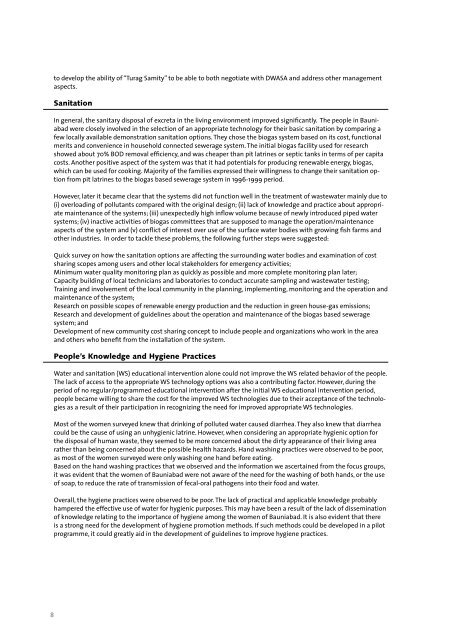Untitled - UNU-IAS - United Nations University
Untitled - UNU-IAS - United Nations University
Untitled - UNU-IAS - United Nations University
Create successful ePaper yourself
Turn your PDF publications into a flip-book with our unique Google optimized e-Paper software.
to develop the ability of “Turag Samity” to be able to both negotiate with DWASA and address other management<br />
aspects.<br />
Sanitation<br />
In general, the sanitary disposal of excreta in the living environment improved significantly. The people in Bauniabad<br />
were closely involved in the selection of an appropriate technology for their basic sanitation by comparing a<br />
few locally available demonstration sanitation options. They chose the biogas system based on its cost, functional<br />
merits and convenience in household connected sewerage system. The initial biogas facility used for research<br />
showed about 70% BOD removal efficiency, and was cheaper than pit latrines or septic tanks in terms of per capita<br />
costs. Another positive aspect of the system was that it had potentials for producing renewable energy, biogas,<br />
which can be used for cooking. Majority of the families expressed their willingness to change their sanitation option<br />
from pit latrines to the biogas based sewerage system in 1996-1999 period.<br />
However, later it became clear that the systems did not function well in the treatment of wastewater mainly due to<br />
(i) overloading of pollutants compared with the original design; (ii) lack of knowledge and practice about appropriate<br />
maintenance of the systems; (iii) unexpectedly high inflow volume because of newly introduced piped water<br />
systems; (iv) inactive activities of biogas committees that are supposed to manage the operation/maintenance<br />
aspects of the system and (v) conflict of interest over use of the surface water bodies with growing fish farms and<br />
other industries. In order to tackle these problems, the following further steps were suggested:<br />
Quick survey on how the sanitation options are affecting the surrounding water bodies and examination of cost<br />
sharing scopes among users and other local stakeholders for emergency activities;<br />
Minimum water quality monitoring plan as quickly as possible and more complete monitoring plan later;<br />
Capacity building of local technicians and laboratories to conduct accurate sampling and wastewater testing;<br />
Training and involvement of the local community in the planning, implementing, monitoring and the operation and<br />
maintenance of the system;<br />
Research on possible scopes of renewable energy production and the reduction in green house-gas emissions;<br />
Research and development of guidelines about the operation and maintenance of the biogas based sewerage<br />
system; and<br />
Development of new community cost sharing concept to include people and organizations who work in the area<br />
and others who benefit from the installation of the system.<br />
People’s Knowledge and Hygiene Practices<br />
Water and sanitation (WS) educational intervention alone could not improve the WS related behavior of the people.<br />
The lack of access to the appropriate WS technology options was also a contributing factor. However, during the<br />
period of no regular/programmed educational intervention after the initial WS educational intervention period,<br />
people became willing to share the cost for the improved WS technologies due to their acceptance of the technologies<br />
as a result of their participation in recognizing the need for improved appropriate WS technologies.<br />
Most of the women surveyed knew that drinking of polluted water caused diarrhea. They also knew that diarrhea<br />
could be the cause of using an unhygienic latrine. However, when considering an appropriate hygienic option for<br />
the disposal of human waste, they seemed to be more concerned about the dirty appearance of their living area<br />
rather than being concerned about the possible health hazards. Hand washing practices were observed to be poor,<br />
as most of the women surveyed were only washing one hand before eating.<br />
Based on the hand washing practices that we observed and the information we ascertained from the focus groups,<br />
it was evident that the women of Bauniabad were not aware of the need for the washing of both hands, or the use<br />
of soap, to reduce the rate of transmission of fecal-oral pathogens into their food and water.<br />
Overall, the hygiene practices were observed to be poor. The lack of practical and applicable knowledge probably<br />
hampered the effective use of water for hygienic purposes. This may have been a result of the lack of dissemination<br />
of knowledge relating to the importance of hygiene among the women of Bauniabad. It is also evident that there<br />
is a strong need for the development of hygiene promotion methods. If such methods could be developed in a pilot<br />
programme, it could greatly aid in the development of guidelines to improve hygiene practices.<br />
8
















